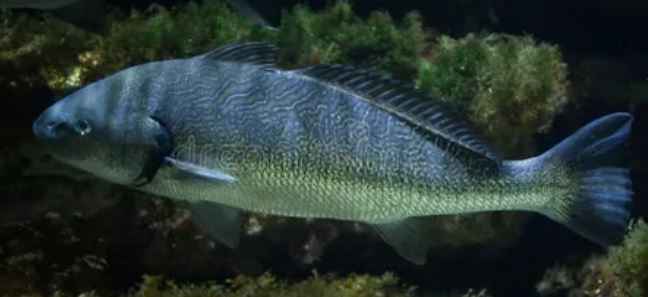Shi drum in fish farming

The shi drum or light croaker is found in the Eastern Atlantic, from the Morroco Coast to the Bay of Biscay. Shi drum is a promising species for growing in the Mediterranean Sea, as well as in the Black Sea.
Content
- Description of shi drum fish
- What does shi drum look like?
- Biology and habitat of the shi drum
- Growing shi drum fish
- Production of shi drum fry
- Shi drum nursery
- Extensive breeding of shi drum
- Intensive breeding of shi drum
Description of shi drum fish
Shi drum or light croaker Latin name Umbrina cirrosa L. is a predatory fish that is valued by fishermen and a promising species for breeding in aquaculture.
What does shi drum look like?
The shi drum (Umbrina cirrosa) has an elongated and tall body, compressed from the sides and rather curved at the top. The fish has a prominent muzzle and a narrow and small mouth. The umbrine is characterized by the presence of a very short and fleshy antennae on the jaw and a carrot-shaped swim bladder, without appendages. The lateral line reaches the tail and is equipped with 50-60 scales, and the caudal fin has a convex shape. Umbrina has a silver-gray color with obliquely sinuous golden stripes bordered by a blue or purple edge, the edge of the gill cover is black. Its dimensions can reach up to 1 m in length and more than 10 kg in weight.
Biology and habitat of the shi drum
Shi drum is present throughout the Mediterranean, Black and Atlantic coasts from Senegal to the Bay of Biscay, and is found in the Sea of Azov. It is so rare in the Black and Azov Seas that it is included in the Red Book of Ukraine. The umbrine usually lives on sandy seabeds, but since it is a highly euryhaline species, its presence is also common in coastal lagoons.
Umbrina spawning occurs in the spring-summer period (May-August), and sexual maturity occurs when the body length is about 37 cm. Maturation and spawning are characterized by the peculiarity of synchrony in groups. Shi drum caviar is relatively small in size (about 0.8 mm) and is of pelagic origin.
Although controlled reproduction of the shi drum has been developed and fish farmers can count on extensive breeding experience, the umbrine cannot yet be considered a simple species for Mediterranean and especially Black Sea aquaculture.
Growing shi drum fish
Production of shi drum fry
Techniques for controlled propagation and rearing of shi drum larvae were first developed in Italy in 1998.
Stimulation of the reproductive phase is achieved both through the use of certain thermal regimes that favor gametogenesis, and through hormonal induction. The ideal temperature for spawning of the shi drum ranges from 22-26°C, while males swim freely in a much wider temperature range (14-26°C). Breeders are kept in special tanks and low stocking densities are recommended to maximize reproductive behavior. Fertilization of eggs is usually less than 50%, so it is advisable to introduce several pairs of spawners into the spawning grounds (3-4).
The shi drum has a fairly rapid development compared to other euryhaline species, because the maturation of eggs at a temperature of 25 ° C occurs in approximately 21 hours, while in the case of sea bream and sea bass, under the same thermal conditions they will require 70 and 80 hours, respectively. The larvae feed on rotifers, and then on nauplii and metanauplii of Artemia salina, enriched with polyunsaturated fatty acids. The larva is particularly thermophilic (up to 29°C) and exhibits such rapid development that it allows the introduction of inert food and the replacement of live prey after 17 days of reproduction. Rearing is completed 40 days after hatching.
Shi drum nursery
Young stages of shi drum are characterized by very rapid growth compared to sea bass and sea bream. In fact, light umbrina, starting with an average size of 50 g, manage to reach a size of 360 g in just 4 months, from July to November (at an average temperature of about 20-22 ° C). Shi drum, after 28 months of development at a final density of 10 kg/m3, can easily reach an average weight of 900 g.
The feed index obtained by feeding commercial dry pelleted feed to animals containing 44% protein and 18% fat is 1.4/1.
Extensive breeding of shi drum
Extensive breeding of the shi drum, carried out in some Venetian lagoons, showed modest results not so much in the growth rate of individuals (July-November 50-220 g), but in the rate of their recapture, which was found to be about 7% of the total. In fact, the shi drum does not respond well to noise coming from trapping structures (workers) and has a high mortality rate. In addition, swimming at shallow depths, characteristic of the shi drum, de barks it as easy prey for ichthyophagous birds.
Breeding shi drum in semi-extensive systems has given very encouraging results. In fact, the shi drum, bred in polyculture with mullet, manages to triple its body weight in just 8 months of breeding, indicating even greater growth than that recorded in modern trials conducted under intensive conditions.
Intensive breeding of shi drum
Shi drum, due to its characteristics of early growth and unpretentiousness, is considered very promising as an additional species. Most breeding experiments have been carried out in hatcheries using concrete tanks, but detailed information on breeding carried out in floating cages is lacking.
There is no doubt that the growth rate and versatility in aquaculture make the shi drum one of the most promising species for Mediterranean and Black Sea aquaculture.